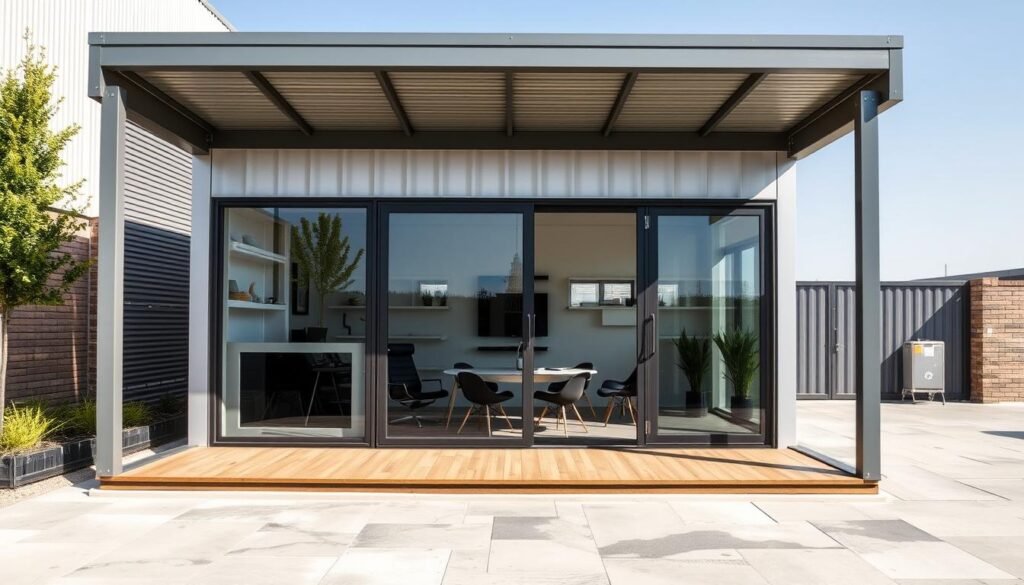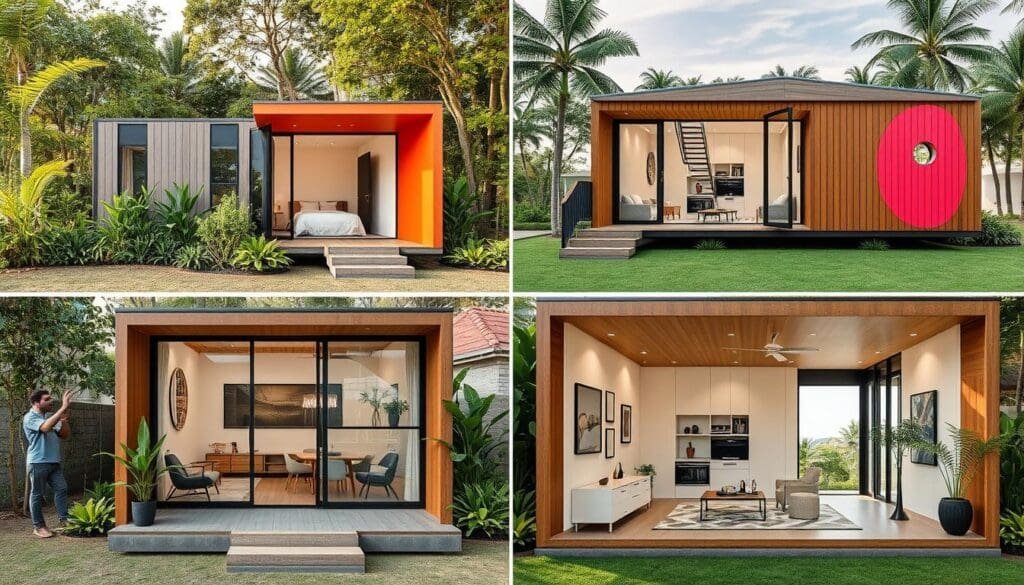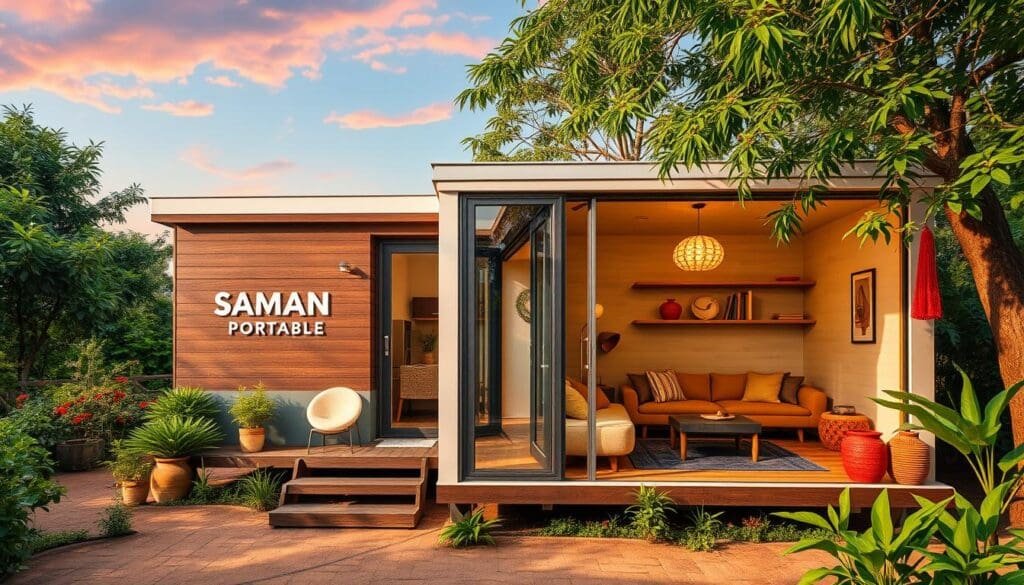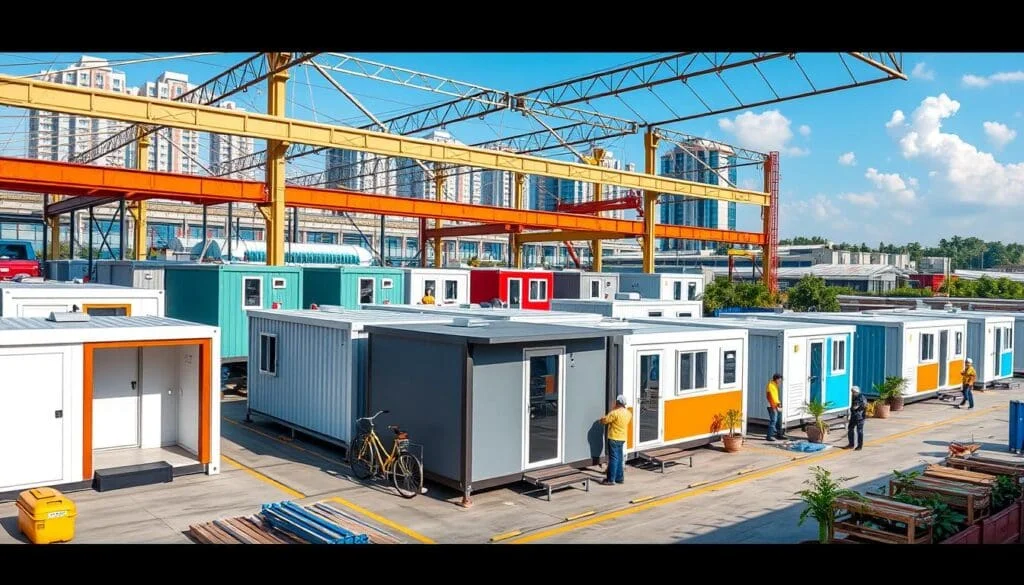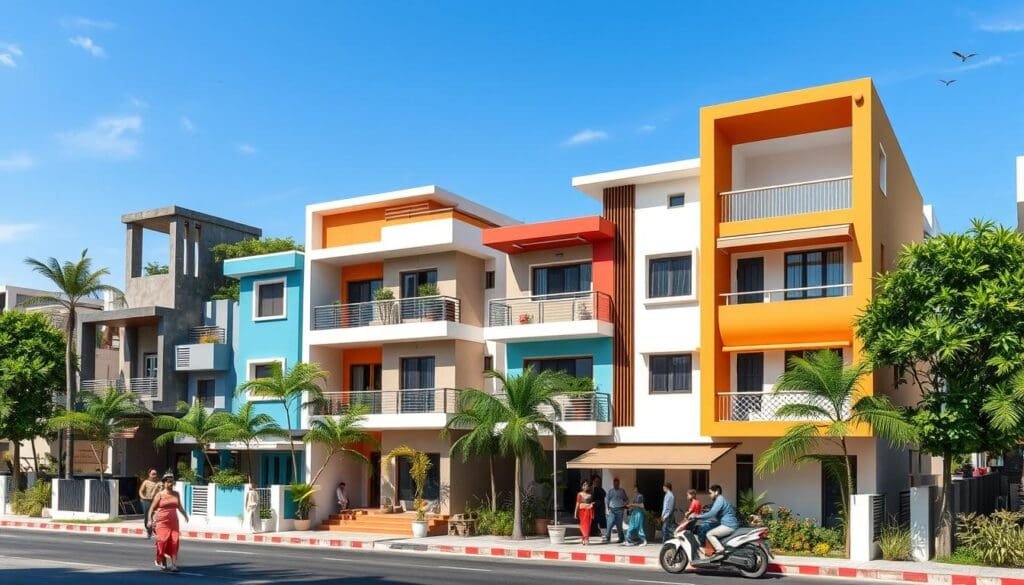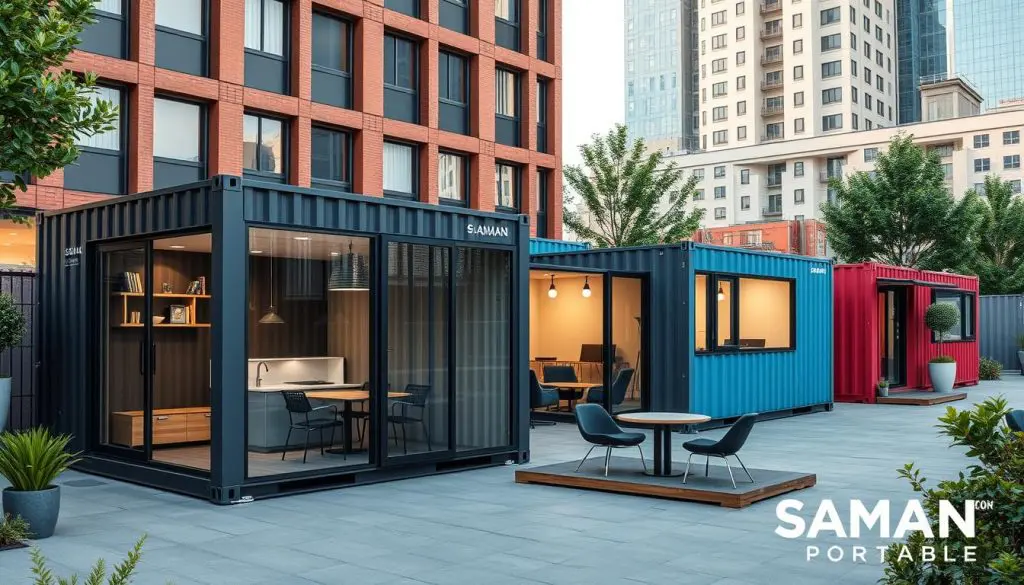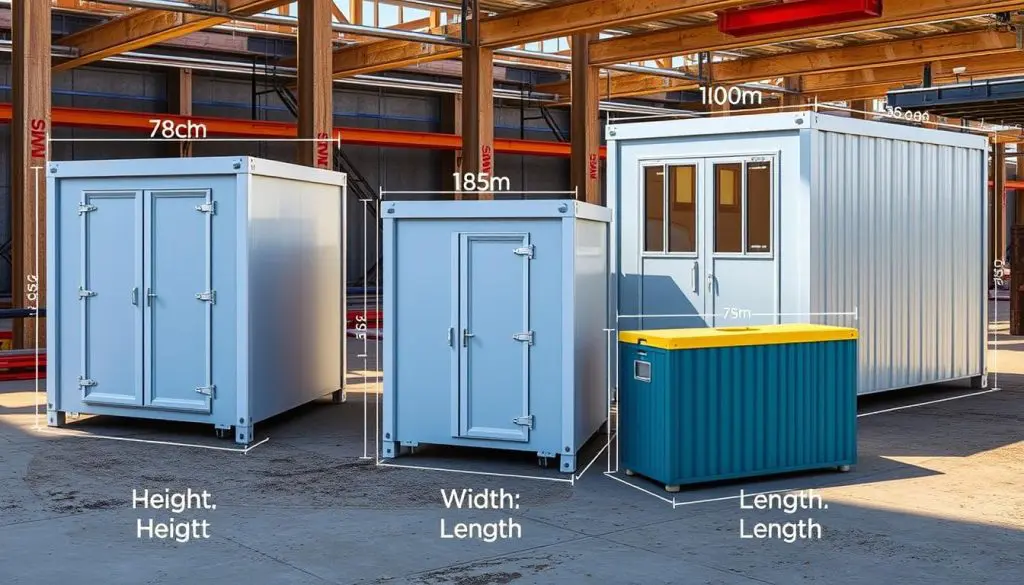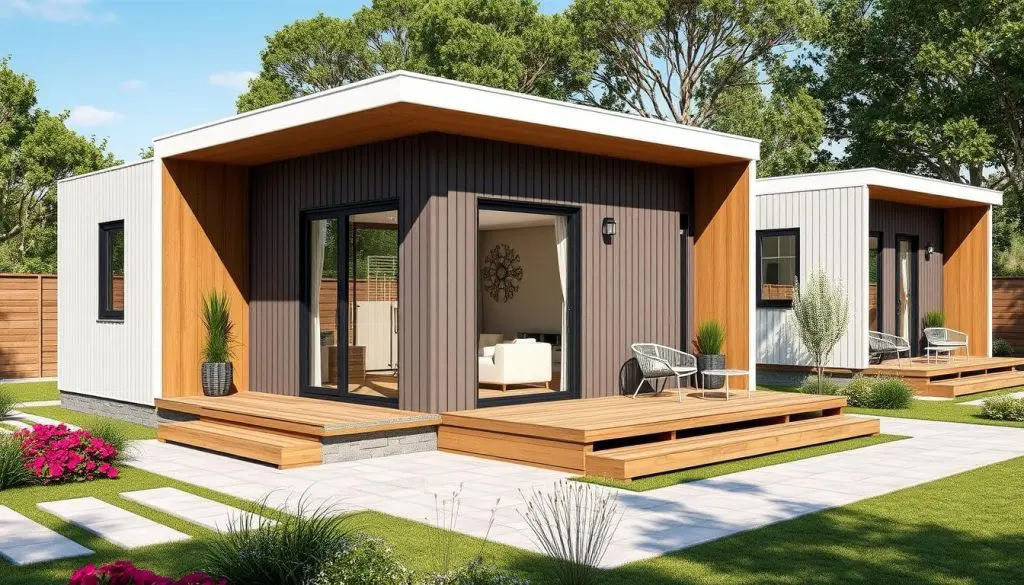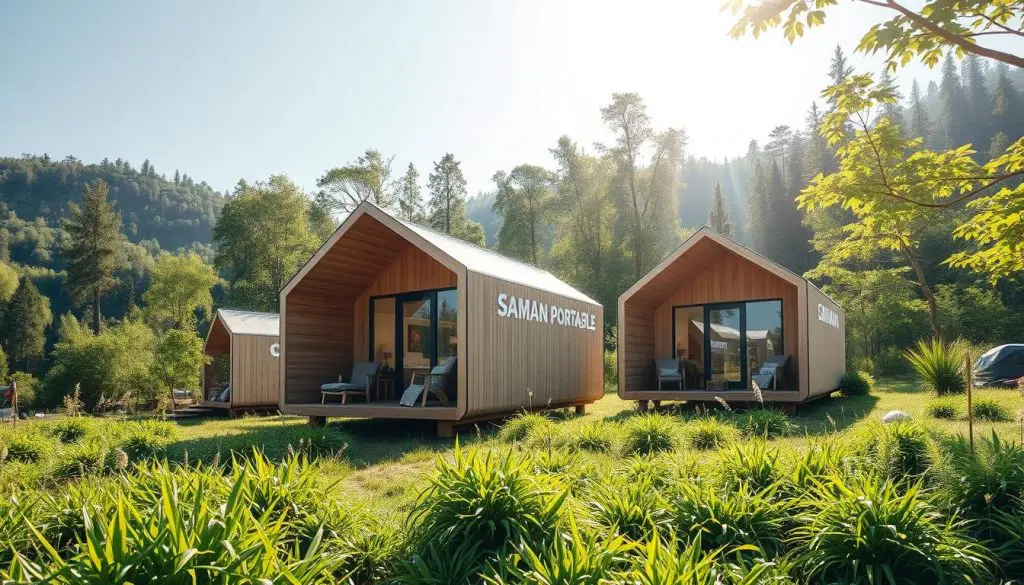The Ultimate Guide to Container Living Spaces: Creating Modern and Flexible Homes from Shipping Containers
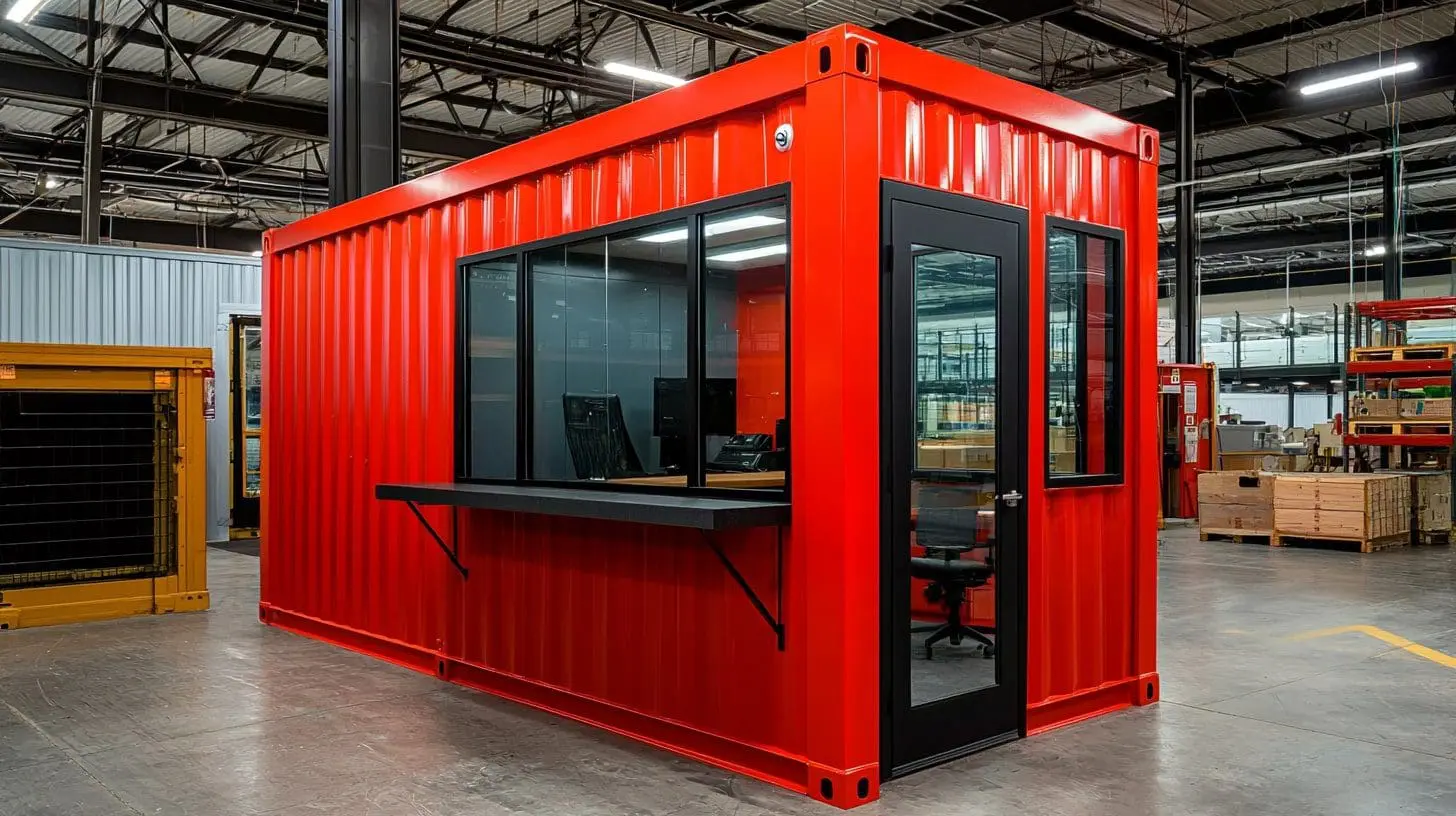
Introduction to Container Living Spaces
Shipping containers have transformed the way we think about sustainable and flexible housing solutions. What once served solely for transporting goods has now evolved into innovative living spaces. Container living spaces offer a unique blend of affordability, durability, and eco-conscious design, attracting homeowners, entrepreneurs, and businesses alike. As interest in tiny homes, minimalism, and green building grows, shipping containers present a viable option for creating functional and stylish spaces tailored to various needs.
In recent years, container living spaces have been adapted to include container homes, offices, porta cabins, and portable offices designed for both personal and professional use. Whether you’re looking to set up a portable cabin for on-site accommodations or interested in a larger container house to meet your residential needs, containers are highly customizable to match your specific vision and requirements. Unlike conventional construction, container-based buildings can be modified to fit any location, be it urban landscapes or remote sites, without the extensive environmental impact.
These versatile structures range from simple container offices used as workspaces or meeting rooms to porta cabins that can be set up as temporary housing on construction sites, events, or emergency areas. Additionally, container houses are ideal for modern living, offering adaptable floor plans, open spaces, and modular elements that homeowners can configure to suit their lifestyles.
For instance, container homes are often chosen for eco-friendly housing projects, especially in locations where traditional building materials are scarce. Similarly, portable offices have become a popular choice among businesses needing flexible work environments that can be relocated as needed. The durable and compact design of portable cabins ensures that these structures withstand various climates and conditions, making them suitable for all sorts of outdoor environments.
Adopting container living as a lifestyle or as a business solution enables you to combine functionality with aesthetic appeal. From porta cabins that serve as multi-purpose spaces to container-based homes with beautifully designed living rooms, these spaces can be optimized for comfort and efficiency. Moreover, companies like Saman Portable specialize in innovative, ready-to-use containers for various purposes, ensuring that clients receive high-quality, durable solutions crafted to meet individual needs.
This guide will explore the different ways you can turn a shipping container into a personalized living space, covering everything from container home living rooms to complete conversions for residential or commercial use. With the right modifications, containers can be transformed into highly functional, stylish spaces that meet today’s demands for sustainable living.
What is a Container for Living Space?
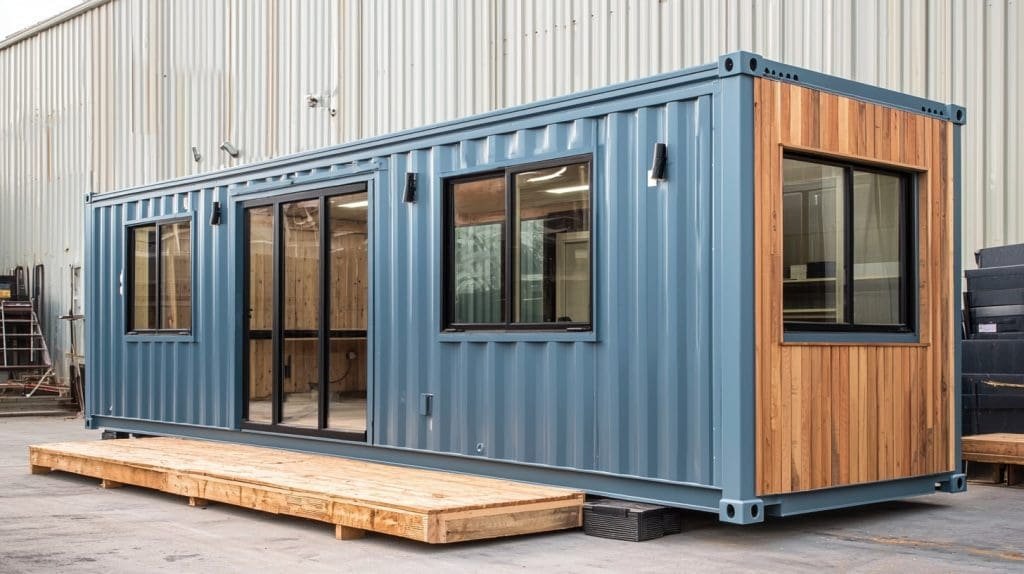
Shipping containers, once purely utilitarian, have taken on new life as adaptable, modern living spaces. With the right modifications, a shipping container can be converted into a highly functional, cozy, and sustainable home. But what exactly makes a shipping container suitable for living? In this section, we’ll dive into the fundamentals of container-based housing and how these robust structures are reshaped into fully equipped spaces for a variety of purposes.
Understanding the Basics of a Living Container
Shipping containers come in various sizes, typically 20 and 40 feet in length, with “high-cube” models offering additional vertical space. These steel containers are built to withstand harsh conditions, making them durable enough for permanent housing in many environments. Unlike traditional homes, container-based structures are designed to be stackable and modular, allowing for flexibility in building multi-container homes with innovative layouts.
Containers are often used for structures like portable cabins and portable offices, which offer compact, functional space solutions. With companies like Saman Portable, which specialize in high-quality, modular solutions, containers can be customized to serve unique purposes, from on-site offices to temporary shelters and more permanent residential homes.
Benefits of Using a Shipping Container as a Living Space
When compared to conventional housing, container living offers several distinct advantages:
- Affordability: Converting a shipping container into a home can be more affordable than traditional construction, especially in areas with high housing costs.
- Sustainability: Repurposing containers reduces waste and encourages eco-friendly building practices. A single container home uses recycled materials, making it an environmentally conscious choice.
- Durability: Shipping containers are made of robust steel, which is weather-resistant and built to last. This durability makes them suitable for various climates, whether they are used as container offices or homes.
- Flexibility: Containers are modular and can be arranged in different configurations, making them ideal for custom-built container houses or multi-unit buildings.
Popular Applications for Containers as Living Spaces
Shipping containers are highly adaptable and can be tailored for diverse uses beyond homes. Here are some popular applications:
- Portable Cabins: Often used for temporary housing or offices on construction sites, these cabins offer quick and convenient shelter solutions.
- Container Offices: For businesses needing on-site flexibility, portable offices provide professional space that can be moved or expanded as needed.
- Residential Homes: From tiny homes to larger, multi-container designs, container homes are fully functional residences with amenities like living rooms, kitchens, and bathrooms.
For those interested in creating a flexible, eco-friendly living solution, container houses by Saman Portable provide an excellent example of how containers can be transformed into comfortable and stylish homes.
Shipping containers are more than just metal boxes—they’re a foundation for a sustainable and customizable lifestyle. In the following sections, we’ll explore the potential of container home living rooms and ideas for transforming container interiors into inviting spaces suited to modern needs.
Benefits of Living in a Container Home
Living in a container home offers unique advantages that set it apart from traditional housing. From affordability to eco-friendliness, container living spaces meet the demands of modern life while offering flexibility and innovation. This section explores the core benefits of container-based homes and highlights why they are becoming increasingly popular as both permanent residences and portable housing options.
Durability and Structural Strength
Shipping containers are designed to withstand the toughest conditions during transport across seas, making them highly durable and resilient against the elements. This structural integrity ensures that container homes can endure extreme weather, including high winds, heavy rain, and even earthquakes. With container houses designed by industry specialists like Saman Portable, homeowners can rest assured that their living space is not only strong but also built to last in various climates and environments.
Cost-Effectiveness of Container Living Spaces
One of the primary appeals of container homes is their affordability. Compared to traditional home construction, building a container home requires fewer materials and less labor, which significantly reduces costs. This cost-effectiveness allows homeowners to invest in customizations and high-quality interiors while staying within budget. Additionally, companies like Saman Portable offer customizable portable cabins and container offices that suit various budgets and can be tailored to specific needs.
Eco-Friendly and Sustainable Design
Repurposing shipping containers for housing is an environmentally friendly choice, aligning with the growing trend of sustainable living. By using recycled containers, container homes reduce waste and minimize the need for traditional building materials. This eco-conscious approach is ideal for those looking to create a smaller carbon footprint. Furthermore, integrating solar panels, rainwater harvesting systems, and other green technologies into container living spaces enhances their sustainability.
Flexibility and Modularity
Container homes offer incredible flexibility in design and layout. The modular nature of containers allows them to be stacked, connected, or expanded as needed. This adaptability is ideal for those who might want to start with a small space and add more containers later. Modular configurations are not only practical but also provide creative freedom to design unique spaces. Whether you need a simple portable office or a multi-unit container office, container structures can be customized to meet diverse requirements.
Quick and Efficient Construction
Compared to traditional construction methods, container homes can be completed much faster. Prefabricated designs, like those offered by Saman Portable, reduce construction time significantly, making it possible to have a ready-to-use portable cabin or container house in a matter of weeks rather than months. This efficiency makes container living ideal for those looking to move into their new home quickly or set up an office space on short notice.
Living in a container home combines durability, cost savings, sustainability, and design flexibility, making it an appealing choice for a wide range of people. In the next section, we’ll dive into the planning process, where we’ll discuss layout, insulation, and essential modifications to transform a shipping container into a comfortable and stylish home.
Planning Your Container Living Space: Key Considerations
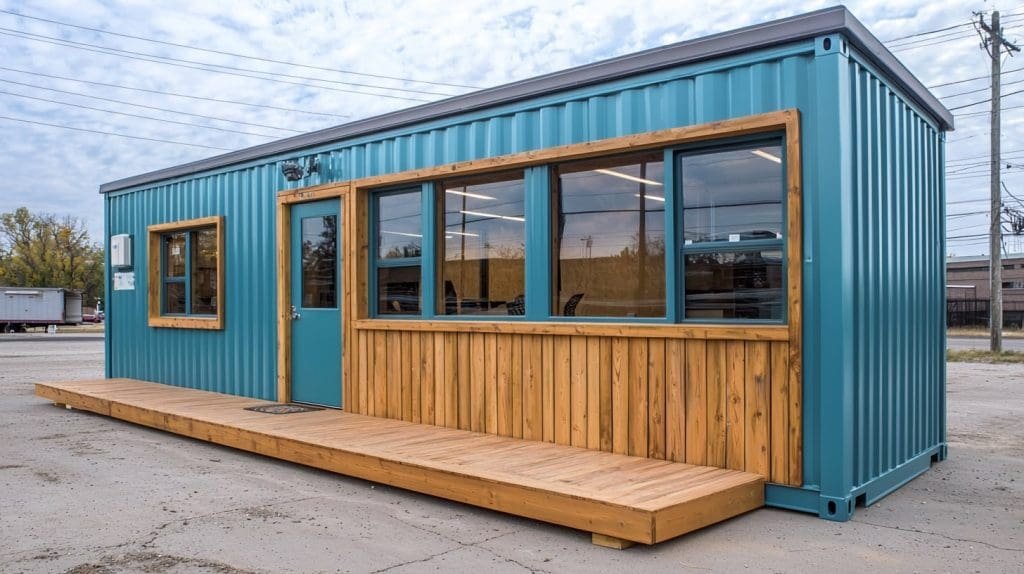
Determining the Layout and Space Needs
One of the first steps in creating a container living space is to determine how you want the interior layout to function. Since containers have limited square footage, maximizing every inch is essential. Open floor plans are popular for container homes, as they make the space feel larger and more versatile. You can choose to combine multiple containers to create additional rooms or designate specific zones for living, dining, and sleeping. Companies like Saman Portable offer customized container house solutions, making it easier to design layouts that fit your lifestyle and needs.
Insulation and Climate Control
Insulation is a critical aspect of making a shipping container comfortable year-round, especially if you live in an area with extreme weather conditions. Proper insulation helps regulate indoor temperature, reduces noise, and prevents condensation buildup. Materials like spray foam, rigid foam, and wool insulation are common choices. Additionally, climate control systems, such as mini-split heating and cooling units, can keep the space comfortable in both hot and cold climates. With well-insulated options from providers like Saman Portable, you can achieve a cozy, energy-efficient container home.
Essential Modifications for Functionality
Modifying a shipping container involves making essential changes like cutting windows, installing doors, and reinforcing walls for safety and usability. Windows bring in natural light, creating a brighter and more open feel. Doors can be installed on one or both ends of the container, depending on your preferred entry points and interior layout. For those considering a portable office or container office, adding ventilation and accessibility features can enhance comfort and functionality.
Electrical and Plumbing Systems
To turn a container into a fully functional living space, you’ll need to install electrical and plumbing systems. This process includes wiring for lighting, outlets, and potentially an internet connection, as well as plumbing for a kitchen or bathroom. It’s essential to work with professionals who understand the structural limitations and requirements of containers. Some companies, such as Saman Portable, provide container setups with basic electrical and plumbing systems in place, which can be customized to meet your specific needs.
Securing Permits and Meeting Local Regulations
Before you begin construction, research the permits and regulations required for container homes in your area. Different locations may have varying zoning laws and building codes, especially when it comes to non-traditional structures like shipping containers. Checking with local authorities ensures your project adheres to safety and compliance standards, helping you avoid legal issues down the road.
Planning a container living space requires careful consideration of layout, climate control, essential modifications, utilities, and legal requirements. Once these foundational elements are in place, you’ll be ready to focus on creating a stylish and functional interior for comfortable container living. In the next section, we’ll look at transforming a container into a living room that blends comfort with efficient use of space.
Converting a Shipping Container into a Living Space
Step-by-Step Guide to Transforming a Container
Transforming a shipping container into a livable space involves several critical steps, each designed to ensure the container is safe, comfortable, and functional as a home. The process begins with selecting the right container, followed by structural modifications, insulation, and finishing touches. Whether you’re aiming to create a portable cabin for temporary use or a long-term container house, this guide will walk you through the essential steps.
1. Selecting the Right Container Type
Shipping containers come in different sizes and types, so choosing the right one depends on your space needs and intended use. The standard sizes are 20 feet and 40 feet, with high-cube models offering extra height for added headroom. High-cube containers are particularly popular for container homes, as they allow for more comfortable living spaces and make it easier to add insulation without compromising on ceiling height. Companies like Saman Portable offer containers that can be customized according to residential or commercial requirements.
2. Structural Modifications and Reinforcements
Modifying the container involves cutting openings for windows, doors, and ventilation. This step is crucial to create natural light, airflow, and easy access. Since cutting into the container can weaken its structural integrity, it’s essential to reinforce areas around large openings. Some homeowners opt for sliding glass doors or large windows to make the space feel open and connected to the outdoors. If you’re setting up a container office, consider adding larger windows for a more inviting work environment. Saman Portable offers office containers with pre-installed openings, saving you time and effort.
3. Insulation for Climate Control
Insulation is one of the most important aspects of container conversions, as it ensures the space remains comfortable throughout the year. Without proper insulation, containers can become extremely hot in summer and cold in winter. Common insulation options include spray foam, rigid board, and blanket insulation, each providing different benefits in terms of energy efficiency and space conservation. Prefabricated porta cabins and portable offices from Saman Portable often come with built-in insulation, streamlining the conversion process.
4. Electrical and Plumbing Installation
For your container to serve as a full-time living space, it must have basic utilities. Electrical systems are necessary for lighting, outlets, and possibly internet connectivity, while plumbing is required if you’re adding a bathroom or kitchen area. This stage requires skilled professionals to ensure that all installations meet safety standards. Many portable cabins include basic electrical setup as part of their design, which can be further customized for your specific needs.
5. Interior Finishing and Customization
Once the structural modifications and utility installations are complete, it’s time to focus on interior finishing. This includes flooring, wall treatments, cabinetry, and furnishing. Many container homeowners opt for simple yet stylish interiors that maximize space efficiency. Durable materials, such as vinyl flooring and wood paneling, are popular choices as they add warmth and texture to the space. Additionally, portable cabins designed by specialists like Saman Portable offer high-quality finishes that can be adapted to various decor styles, from modern minimalist to rustic.
Converting a shipping container into a living space is a rewarding project that combines creativity with practical design. With the right planning and professional help, a container can be transformed into a stylish, comfortable, and fully functional home or office. In the following section, we’ll explore design ideas specifically for the container home living room, focusing on ways to maximize comfort and aesthetic appeal in a compact space.
Design Ideas for a Container Home Living Room
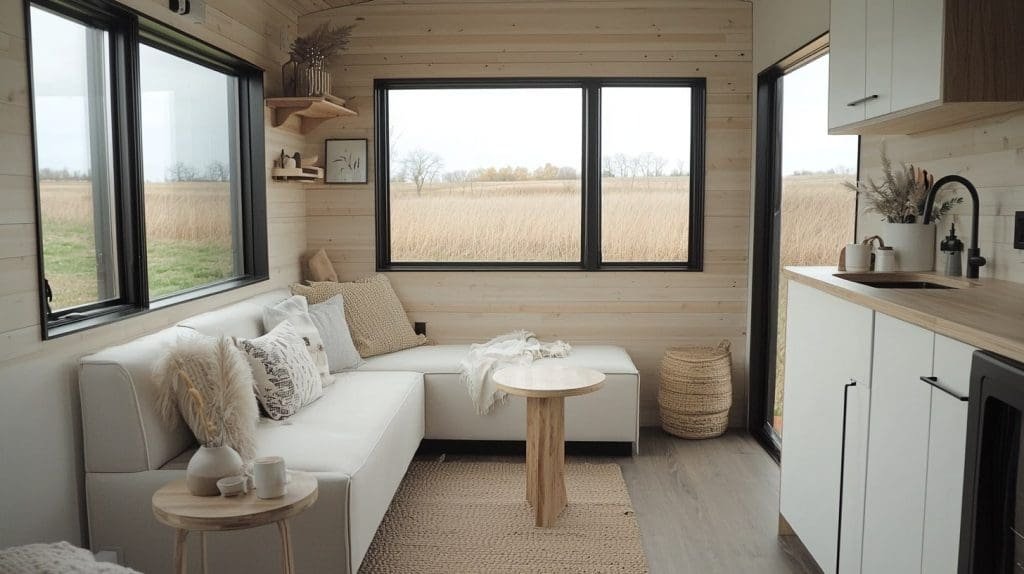
Creating a Comfortable and Functional Living Area
The living room is the heart of any home, and a container home is no exception. While container homes typically have limited space, thoughtful design can make a container home living room feel open, inviting, and functional. By choosing versatile furniture, utilizing natural light, and employing smart storage solutions, you can create a living room that blends comfort and style seamlessly.
Maximizing Space with an Open Floor Plan
One of the best ways to make a compact container home feel spacious is by adopting an open floor plan. Combining the living, dining, and kitchen areas into one cohesive space reduces the need for walls, which can make the interior feel cramped. In an open layout, the container living room flows naturally into the kitchen and dining area, creating a more unified look. For instance, multi-functional spaces are popular in container offices and portable offices as they maximize efficiency within a compact footprint, and the same concept can be applied to residential spaces.
Choosing Multi-Functional Furniture
Since space is at a premium in container homes, opting for multi-functional furniture can make a significant difference. Look for pieces that serve more than one purpose, such as sofa beds, fold-out tables, and storage ottomans. These items allow you to maintain a stylish living area without cluttering the space. For inspiration, portable cabins often include built-in storage and convertible furniture to optimize limited space, which can be adapted to container home living rooms as well. This approach is not only functional but also helps keep your living room clean and organized.
Using Natural Light to Create a Bright and Airy Atmosphere
Natural light is essential for making a small space feel larger and more welcoming. Large windows, skylights, and glass doors can transform a container home’s interior by bringing in sunlight and creating a connection with the outdoors. Additionally, natural light reduces the need for artificial lighting during the day, saving energy and enhancing the home’s sustainability. Many container houses are designed with strategically placed windows to maximize light exposure and create an open ambiance. If you’re designing your own container living space, consider installing floor-to-ceiling windows in the living room to amplify the sense of openness.
Adding Personal Touches with Decor and Accessories
To make your container home living room truly feel like home, incorporate personal decor elements that reflect your style. Adding a few well-chosen pieces—like area rugs, throw pillows, or artwork—can warm up the space and add character. Plants are another great addition, bringing life and color into the room while also improving air quality. For a streamlined, cohesive look, choose decor that complements the modern, industrial feel of a container structure. Companies like Saman Portable provide containers with minimalist designs, which serve as an ideal canvas for personalizing your living room.
Incorporating Smart Storage Solutions
Effective storage is crucial in a small living room. Built-in shelves, wall-mounted cabinets, and under-furniture storage help maximize space without sacrificing style. Consider integrating shelves or cabinets into your living room walls to save floor space and maintain an open layout. In portable cabins and portable offices, storage solutions are often creatively incorporated to maximize utility, which can be a source of inspiration for your container home.
By thoughtfully arranging furniture, utilizing natural light, and choosing decor that reflects your personal taste, your container home living room can be both functional and stylish. In the next section, we’ll explore different options for choosing the right location for your container home, covering factors like site preparation, zoning laws, and environmental considerations.
Choosing the Right Location for Your Container Home
Key Factors for Selecting a Site
When building a container home, the location you choose has a significant impact on both functionality and overall experience. From practical elements like access to utilities to aesthetic considerations like views and surroundings, selecting the right site ensures that your container living space meets all your needs. Whether you’re establishing a portable cabin for temporary living or a permanent container house, here are some essential factors to keep in mind when choosing the best location.
Site Preparation and Foundation Needs
One of the first steps in establishing a container home is preparing the site. Shipping containers are designed to be placed on sturdy surfaces, so having a strong foundation is essential. Depending on the location and climate, foundations can range from simple concrete slabs to elevated piers for areas prone to flooding. Site preparation may also include leveling the ground and ensuring easy access for the delivery of your container. Companies like Saman Portable offer a range of container housing solutions that can be customized for various terrains, making it easier to adapt your design to the chosen environment.
Zoning Regulations and Building Codes
Understanding zoning regulations and building codes is crucial when establishing a container home, as local laws vary widely. Some areas may have restrictions on non-traditional structures like container offices or portable cabins, particularly in residential neighborhoods. Before you begin construction, check with local authorities to ensure compliance with all relevant regulations. For businesses planning to set up a portable office on a new site, companies such as Saman Portable offer pre-approved designs that may simplify the permitting process in certain areas.
Access to Utilities and Connectivity
Ensuring access to essential utilities like water, electricity, and sewage is key to making a container home livable. While some container homes are designed to be off-grid, many homeowners prefer connecting to local utility systems for convenience. If your site is remote, consider alternative energy solutions such as solar power and rainwater harvesting. Portable cabins from Saman Portable can be fitted with basic utility hookups, allowing you to easily connect to existing infrastructure or set up sustainable systems.
Environmental Considerations and Climate
The climate of your location affects various aspects of container living, from insulation needs to positioning for natural light. In colder areas, you may need to invest in high-quality insulation to keep your container home warm and energy-efficient. On the other hand, hot climates may require additional ventilation and cooling systems. The orientation of your container can also impact its energy efficiency; positioning windows and doors to maximize natural light can reduce the need for artificial lighting. Portable cabins and container offices designed for specific climates can be customized to include features like enhanced insulation and solar panels to improve comfort and efficiency.
Choosing the right location for your container home involves more than just picking a scenic spot. By considering foundational requirements, zoning laws, utility access, and environmental factors, you can ensure a smooth setup process and a comfortable living experience. In the next section, we’ll explore multi-container designs and how you can expand your container home with additional units to create a more spacious and functional environment.
Expanding Container Living Spaces: Multi-Container Designs
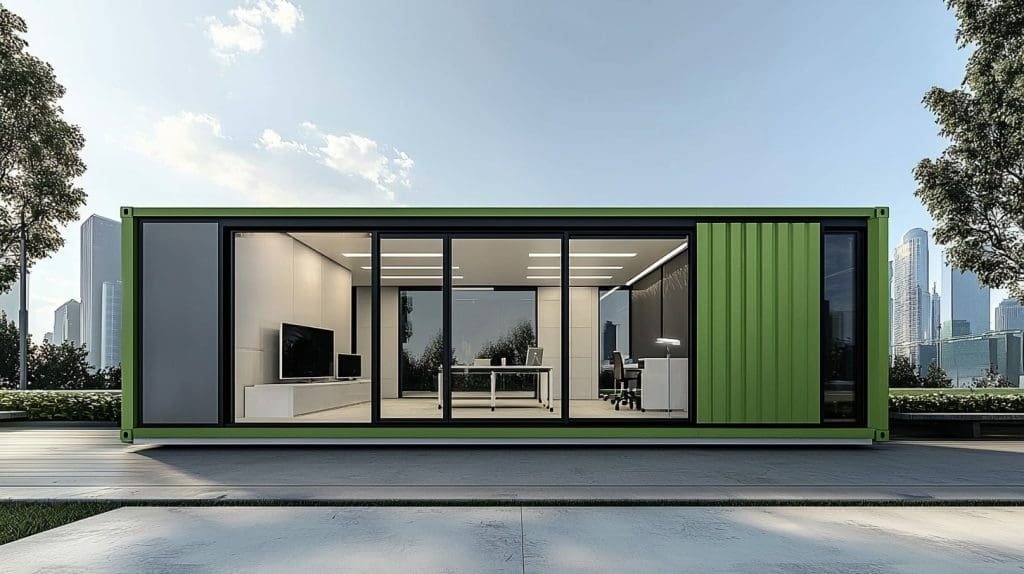
Using Multiple Containers for Added Space
One of the greatest advantages of container homes is their modularity, which makes it easy to expand the space by adding more containers. Multi-container designs allow homeowners to create more spacious layouts, whether adding extra rooms or creating multi-story structures. For those considering a larger container house, combining multiple containers provides flexibility in layout and functionality, making it possible to have designated living, dining, and sleeping areas. For example, Saman Portable offers customizable container units that can be seamlessly connected, allowing homeowners to design larger homes that meet their specific needs.
Popular Configurations for Multi-Container Homes
Multi-container homes come in a variety of configurations. The most common layout involves placing containers side-by-side to create a larger open floor plan, ideal for spacious living rooms or container offices. Another popular configuration is the stacked design, where containers are stacked vertically to create a multi-story home or workspace. This approach is especially useful for smaller plots of land, as it maximizes vertical space. Portable offices with multiple containers stacked in unique designs offer dynamic work environments that blend functionality with modern style.
Connecting and Customizing Multiple Containers
When combining multiple containers, connecting them properly is essential to ensure structural stability. This often involves welding the containers together and reinforcing them around openings. Additionally, wall panels may need to be removed or modified to create larger, seamless spaces between containers. For instance, multi-unit portable cabins from Saman Portable are designed to be easily connected, offering flexible living or working spaces that feel spacious and cohesive. Customizing these connections also allows homeowners to control the flow and privacy of each area within the home.
Functional Additions for Multi-Container Spaces
Adding multiple containers provides the opportunity to create specialized spaces within the home. For instance, an extra container can be converted into a dedicated office, workshop, or studio, especially useful for those working remotely or needing a private workspace. Some multi-container setups also include portable cabins that serve as guest rooms or additional bedrooms. With options like container offices, expanding the space can accommodate growing needs without the hassle of traditional construction.
Maximizing Outdoor Space with Multi-Container Designs
Multi-container designs often allow for more outdoor space, as containers can be arranged around a central courtyard or deck area, creating a blend of indoor and outdoor living. Placing containers in an L-shape or U-shape configuration provides a private outdoor area, ideal for family gatherings or relaxing in a garden setting. Adding decks, patios, or rooftop terraces can further enhance the versatility and appeal of multi-container homes. For inspiration, Saman Portable offers options that are easily adaptable to unique outdoor settings, helping homeowners make the most of their surroundings.
Expanding a container home with multiple units opens up endless design possibilities, allowing for greater functionality and personalization. In the following section, we’ll cover essential modifications for container living spaces, focusing on insulation, ventilation, and climate control to ensure a comfortable, year-round environment.
Essential Modifications for Container Living Spaces
Insulation for Year-Round Comfort
One of the most critical aspects of transforming a container into a livable space is insulation. Shipping containers are made of steel, which can become extremely hot in the summer and very cold in the winter. Proper insulation helps regulate the temperature, making the interior comfortable regardless of the season. Common insulation materials include spray foam, rigid board, and blanket insulation, each with its own benefits in terms of cost, efficiency, and ease of installation. Companies like Saman Portable offer pre-insulated container houses, which can save time and effort in the construction process.
Ventilation and Airflow
Good ventilation is essential to ensure fresh air circulation and prevent condensation buildup, which can lead to mold and structural damage. Many container homeowners install vents, windows, or even skylights to facilitate airflow and bring in natural light. Portable offices and portable cabins often come with built-in ventilation options, making them well-suited for environments that require airflow without compromising security. Saman Portable offers customizable container units where ventilation can be tailored to specific climate needs, making it easier to maintain a fresh and comfortable interior.
Windows and Doors for Natural Light
Adding windows and doors is a fundamental step in creating an inviting container living space. Windows bring in natural light, making small spaces feel larger and more welcoming. Sliding glass doors or floor-to-ceiling windows are popular choices for container homes, providing expansive views and enhancing indoor-outdoor flow. If privacy or security is a concern, homeowners can install smaller windows or choose tempered glass for added protection. Container offices designed by companies like Saman Portable often feature strategically placed windows to optimize light without compromising security.
Electrical and Plumbing Systems
For a container home to function as a permanent living space, electrical and plumbing installations are essential. Electrical wiring allows for lighting, outlets, and power for appliances, while plumbing is required if you plan to add a kitchen or bathroom. Some container units, such as porta cabins and portable cabins offered by Saman Portable, come pre-configured with basic electrical and plumbing systems, which can be further customized to meet specific needs. It’s essential to work with professionals experienced in container modifications to ensure safety and compliance with local building codes.
Climate Control Options
Since containers can easily absorb heat and cold, installing effective climate control systems is crucial. Mini-split systems are popular choices for container homes, providing both heating and cooling in a compact unit. These systems are energy-efficient and easy to install, making them ideal for small spaces. For more sustainable solutions, homeowners may consider incorporating solar panels or energy-efficient HVAC systems. Portable cabins and container houses with climate control modifications help maintain a comfortable interior while reducing energy costs over time.
By making these essential modifications—insulation, ventilation, natural light, utilities, and climate control—you can turn a basic container into a cozy and livable home. In the next section, we’ll cover energy efficiency in container living spaces, exploring renewable energy options and sustainable practices to create a greener home environment.
Energy Efficiency in Container Living Spaces
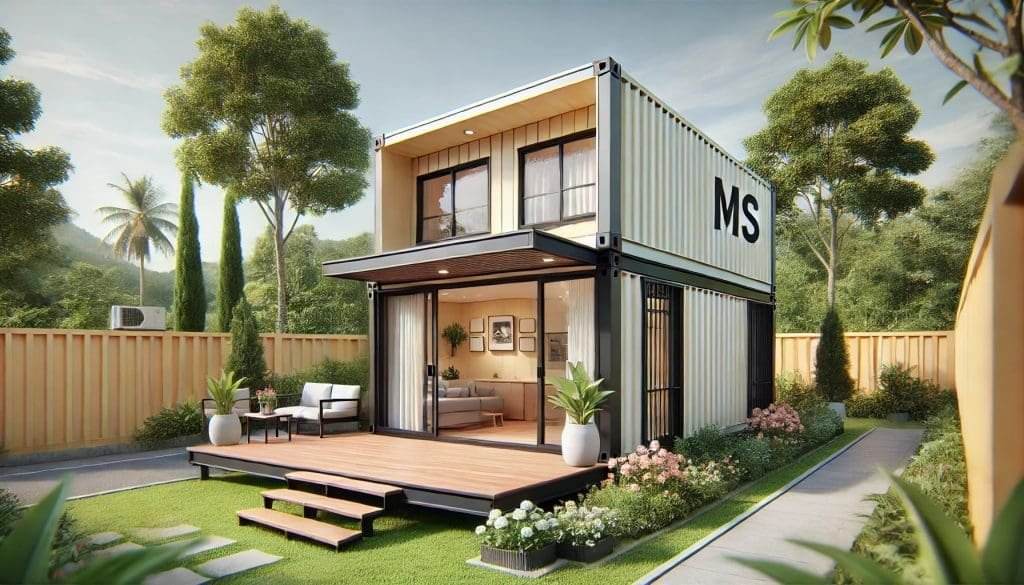
Utilizing Renewable Energy Sources
One of the advantages of container homes is their compatibility with sustainable, renewable energy sources. Solar panels are particularly popular for container living spaces, as they can be installed on the roof of the container, providing a reliable energy source without taking up additional ground space. Wind turbines are another option, especially in remote or rural areas where solar may be less consistent. Using renewable energy not only reduces electricity costs but also aligns with the eco-friendly philosophy of repurposing shipping containers for housing. Many portable cabins and container houses from providers like Saman Portable can be customized to integrate solar panels or other renewable systems, allowing for an off-grid lifestyle.
Insulation for Reduced Energy Consumption
Proper insulation is essential for maintaining energy efficiency within a container home. Insulation helps regulate indoor temperatures, reducing the need for heating and cooling systems and thus conserving energy. Spray foam insulation is a common choice, as it provides excellent coverage and minimizes air leakage. Container offices and portable offices equipped with high-quality insulation help reduce energy costs by keeping the interior comfortable throughout the year. Companies like Saman Portable offer insulated container units that enhance energy efficiency, making them ideal for both residential and commercial uses.
Efficient Lighting Options
Energy-efficient lighting is a simple yet effective way to reduce energy consumption in a container home. LED lights are ideal, as they use significantly less power than traditional bulbs and have a longer lifespan. Skylights or larger windows are also great additions to increase natural light, which reduces the need for artificial lighting during the day. In portable cabins and other container spaces, strategically placed lighting can help illuminate the entire area without excess energy usage. Some container houses offered by Saman Portable come pre-fitted with energy-efficient lighting, creating a sustainable, low-energy living environment.
Smart Climate Control Systems
Efficient heating and cooling systems can drastically impact energy usage in a container home. Mini-split HVAC systems, for example, are compact and highly efficient, making them suitable for the limited space of a container. Many homeowners opt for programmable thermostats to control temperature settings, which can help manage energy usage based on daily schedules. Portable cabins designed for both hot and cold climates benefit from climate control systems that optimize energy use, keeping the interior comfortable year-round while minimizing utility bills. Saman Portable offers container units that are adaptable to different climate control systems, making energy management straightforward.
Water Conservation Techniques
Water-saving features, like low-flow faucets, showerheads, and dual-flush toilets, can make a container home more sustainable and cost-effective. Rainwater harvesting systems are also practical additions, allowing homeowners to collect and store water for landscaping, cleaning, or even household use. For those living in container offices or portable offices, water-saving fixtures reduce water usage without compromising functionality. Some porta cabins from Saman Portable are compatible with water conservation systems, supporting sustainable practices in both residential and commercial spaces.
By incorporating renewable energy sources, efficient lighting, smart climate control, and water conservation methods, container homes can achieve high levels of energy efficiency. In the next section, we’ll focus on storage solutions within container homes, offering tips on maximizing space without compromising style or functionality.
Storage Solutions for Container Homes
Built-In Storage for Compact Spaces
One of the biggest challenges in container homes is finding ways to optimize storage without compromising on space. Built-in storage solutions are an excellent way to keep a container home organized and clutter-free. Many homeowners opt for custom shelving units, cabinets, and wall-mounted storage to maximize every inch of available space. For example, portable cabins designed by Saman Portable often come with built-in storage options tailored to the needs of small spaces, providing homeowners with functional and space-saving solutions.
Under-Furniture Storage Options
In compact living spaces, furniture that doubles as storage is essential. Beds with built-in drawers, ottomans with hidden compartments, and coffee tables with shelving underneath are all great options for container homes. These multi-functional furniture pieces help save space while adding storage capacity. Many container offices and portable offices also incorporate under-desk or modular furniture options to maintain a tidy and organized work environment. Companies like Saman Portable provide container office setups with efficient storage options that keep the workspace uncluttered.
Vertical Storage for Small Spaces
Utilizing vertical space is key in a container home where floor space is limited. Wall-mounted shelves, hanging racks, and hooks allow you to store items without taking up valuable floor area. Vertical storage solutions are especially useful in the kitchen and bathroom, where small items can easily create clutter. For porta cabins and container houses, vertical storage solutions help create a streamlined look while keeping everything within easy reach. Saman Portable offers modular designs that can accommodate vertical storage, making it easy to personalize your space.
Customized Storage Solutions for Unique Needs
One of the benefits of container living is the ability to customize the interior layout, allowing for personalized storage solutions. Custom-built closets, fold-away desks, and tailored cabinetry can be designed to fit unique dimensions, creating storage that meets specific needs. This is particularly beneficial for those using portable cabins as temporary or long-term residences, as it allows for maximum flexibility. With providers like Saman Portable, you can design storage systems that integrate seamlessly with the container’s structure, giving you practical yet stylish storage solutions.
Outdoor Storage Options
For container homes with outdoor space, additional storage solutions can be incorporated outside. Weatherproof storage units, tool sheds, and storage benches are excellent for storing larger items, gardening tools, or seasonal decorations. Arranging containers in an L-shape or U-shape around a central courtyard can also provide extra outdoor storage space in a functional layout. These outdoor storage options can complement indoor solutions, keeping the interior organized and spacious. Portable cabins set up in remote or outdoor locations, like those from Saman Portable, benefit greatly from such outdoor storage.
Incorporating effective storage solutions in a container home enhances functionality while keeping the space organized and appealing. In the next section, we’ll discuss outdoor extensions and living spaces for container homes, covering ways to create decks, patios, and rooftop gardens to extend the usable living area.
Outdoor Extensions and Living Spaces for Container Homes
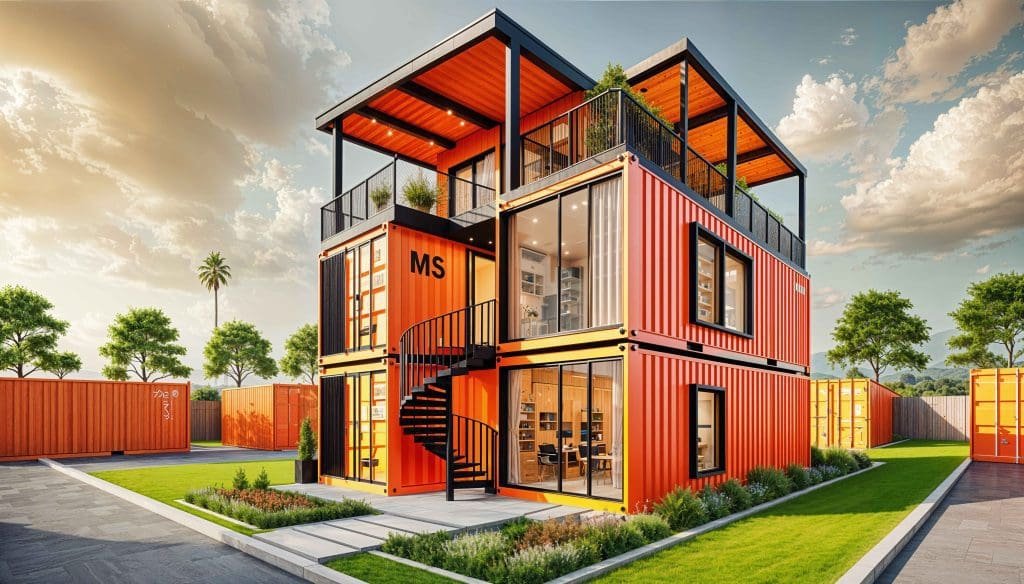
Creating a Deck or Patio Area
Adding a deck or patio to a container home extends the living space and creates a seamless indoor-outdoor transition. A patio or deck not only increases your functional living area but also provides an ideal spot for outdoor dining, relaxation, or entertaining guests. Wood, composite decking, or even eco-friendly recycled materials can be used to create a cohesive and inviting outdoor area that complements the modern aesthetic of a container home. For portable cabins or container houses, companies like Saman Portable can design adaptable units that allow for easy deck installations, giving homeowners the flexibility to enhance their outdoor space as needed.
Incorporating Rooftop Gardens or Terraces
For container homes located in areas with limited outdoor space, rooftop gardens and terraces are excellent ways to utilize every inch of the structure. A rooftop terrace can serve as a cozy retreat or even a productive garden area for growing herbs, vegetables, and flowers. Adding a rooftop garden not only expands the usable space but also improves insulation and energy efficiency by creating a green layer that helps regulate indoor temperatures. Some container offices or portable offices are designed to support rooftop structures, allowing businesses to use these spaces creatively. For inspiration, check out modular units from Saman Portable that can be adapted for rooftop uses.
Utilizing Courtyards and Central Spaces
For multi-container designs, arranging containers around a central courtyard or shared outdoor area provides a private, spacious outdoor living area. This layout is perfect for families or groups, offering a communal outdoor space that enhances social interaction while maintaining privacy. Courtyard designs are common in portable cabins or larger porta cabin arrangements, especially when multiple units are used together. Providers like Saman Portable can help configure these container setups to create inviting courtyards, enhancing the outdoor living experience.
Adding Shade Structures and Pergolas
To make outdoor spaces more comfortable in hot or sunny climates, consider adding shade structures like pergolas, canopies, or retractable awnings. These elements offer sun protection while creating a visually appealing focal point. Shade structures are particularly beneficial for container homes used in warm regions, as they reduce heat exposure and make outdoor areas more enjoyable. With the right setup, shaded patios or terraces become natural extensions of the indoor space, providing comfort and functionality. Portable cabins designed by Saman Portable can also be enhanced with these shade solutions, making them suitable for various climates and outdoor activities.
Creating Outdoor Kitchens or BBQ Areas
For those who enjoy entertaining outdoors, creating a dedicated outdoor kitchen or BBQ area can be a great addition to a container home. A simple countertop, a grill, and some storage can transform a deck or patio into a complete outdoor kitchen, perfect for family gatherings or summer parties. This addition adds functionality and value to a container home, making it a versatile and enjoyable space. Outdoor kitchens are popular in container houses with open layouts, as they allow for seamless transitions between cooking, dining, and relaxation areas. Saman Portable offers container home setups that can be customized to support outdoor extensions, making it easy to create a fully integrated indoor-outdoor experience.
Outdoor extensions like decks, rooftop gardens, and shaded patios allow container homes to adapt to various lifestyles and climates. In the next section, we’ll address frequently asked questions about container living spaces, covering topics from maintenance and cost to design flexibility and durability.
Frequently Asked Questions About Container Living Spaces
Are Container Homes Durable and Long-Lasting?
Yes, container homes are extremely durable, built to withstand the harshest conditions when used for shipping. Made of heavy-duty steel, containers resist wind, water, and pests, making them highly resilient structures. With proper care and maintenance, a container home can last for several decades. Portable cabins designed by companies like Saman Portable are crafted with additional reinforcements and finishes that further enhance durability, ensuring these spaces stand the test of time in various climates.
How Much Does it Cost to Build a Container Home?
The cost of building a container home varies based on size, customization, and amenities. A basic single-container home can be more affordable than traditional construction, while multi-container designs with extensive modifications and upscale interiors can cost significantly more. Prefabricated container offices and portable offices from Saman Portable offer budget-friendly options that include essential features, allowing customers to get an affordable yet functional space tailored to their needs.
Do Container Homes Require Permits?
Yes, container homes generally require permits, much like any other type of residence. Permit requirements depend on local zoning laws and building codes, which can vary widely. For instance, some areas have specific guidelines for non-traditional structures like porta cabins or container houses. It’s important to consult with local authorities to understand the permits and regulations for container homes in your area. Companies like Saman Portable often provide guidance on compliance, making the process easier for homeowners.
How Energy-Efficient Are Container Homes?
Container homes can be very energy-efficient, especially when modified with proper insulation, energy-efficient windows, and renewable energy sources like solar panels. Insulation and ventilation are essential for maintaining a comfortable indoor climate, as containers are made from metal, which conducts heat and cold. Adding energy-efficient features can make a significant difference in reducing energy costs. Many portable cabins come pre-fitted with insulation, and providers like Saman Portable offer options that can be customized for energy efficiency.
Is It Possible to Expand a Container Home in the Future?
Yes, one of the benefits of container homes is their modularity, which allows for easy expansion. You can add additional containers to create more space as your needs change. Multi-container designs are common for container offices and larger homes, allowing for new configurations without extensive reconstruction. Saman Portable provides flexible layouts and configurations, making it easy to expand your container living space as needed.
These frequently asked questions address common concerns and provide valuable insights for those considering a container living space. In the final section, we’ll explore the benefits of choosing a reliable provider, such as Saman Portable, and the value they bring to creating high-quality, customizable container spaces.
Choosing the Right Provider for Your Container Home
The Importance of Quality and Experience
Selecting the right provider for your container home is crucial to ensure quality, customization options, and reliable service. An experienced provider will offer durable materials, customization expertise, and support through the setup and installation process. Working with a reputable company, like Saman Portable, gives you access to a wide range of options, from portable cabins to multi-container designs, ensuring that your container home meets both aesthetic and functional needs.
Customization Options for Diverse Needs
Container homes, offices, and other spaces require unique customization to adapt to their intended use. For instance, a portable office may require specific features like enhanced ventilation, energy-efficient lighting, and ergonomic layouts, while a container house might focus more on comfort and residential features such as kitchen and bathroom setups. Providers like Saman Portable offer extensive customization options, allowing clients to tailor their space based on lifestyle, climate, and functionality.
Range of Products to Suit Different Applications
A reliable provider will offer a variety of container-based products, making it easy to choose a setup that suits your needs, whether for residential, commercial, or temporary use. Saman Portable, for instance, provides container offices, porta cabins, and portable cabins that can be adapted for various purposes, from temporary site offices to permanent homes. Their container houses are designed to accommodate modern amenities while remaining energy-efficient and sustainable, ideal for eco-conscious homeowners.
Support and Guidance Throughout the Process
Building a container home involves multiple steps, from obtaining permits to managing modifications and installations. Partnering with a knowledgeable provider means you’ll receive guidance through each phase, from design to compliance with local regulations. Experienced providers like Saman Portable often assist clients in navigating permit requirements and ensure all modifications meet safety standards, making the building process smooth and stress-free.
Long-Term Durability and Warranty
Quality providers back their products with warranties and support services, ensuring that your container home or office will stand up to long-term use. Durable materials, weather-resistant finishes, and attention to detail in construction mean that your container space will remain functional and appealing for years. Saman Portable offers products designed for longevity, even in harsh conditions, giving customers peace of mind and added value in their investment.
Choosing a reputable provider with extensive experience, a range of products, and strong support services can make all the difference in the success and satisfaction of your container home project. In the next and final section, we’ll summarize the main benefits of container living spaces and why they continue to grow as a sustainable and innovative housing solution.
Conclusion – Embracing the Future of Container Living Spaces
A Sustainable and Versatile Housing Solution
Container living spaces are more than just a trend—they represent a shift towards sustainable, adaptable, and cost-effective housing solutions. By repurposing shipping containers, homeowners and businesses can minimize environmental impact while enjoying the benefits of a durable and highly customizable structure. From portable cabins to expansive container houses, these structures cater to various needs, from temporary accommodations to permanent residences. They offer a sustainable alternative that aligns with the goals of eco-conscious individuals and businesses alike.
Flexibility to Meet Diverse Lifestyle and Business Needs
One of the standout features of container living spaces is their versatility. Whether you’re a business looking for a container office that can move with you, or a homeowner seeking an innovative layout with multi-container designs, container structures provide a level of adaptability rarely seen in traditional construction. Companies like Saman Portable have been instrumental in advancing this adaptability, offering portable offices, porta cabins, and custom container solutions that evolve with the needs of their clients. This flexibility extends to the outdoor spaces as well, with options for patios, rooftop gardens, and even outdoor kitchens, creating a seamless blend of indoor and outdoor living.
Affordable and Time-Efficient Construction
Container living spaces are not only affordable compared to conventional buildings, but they also offer faster construction times. Prefabricated containers and portable cabins from providers like Saman Portable can be set up in a matter of weeks, rather than the months or even years typical of standard home construction. This efficiency allows both individuals and businesses to quickly establish functional and stylish spaces without the prolonged delays and expenses often associated with traditional building projects.
Innovative Design Possibilities
From minimalist interiors to modern layouts with open floor plans, container homes offer ample opportunities for creative expression. The modular design enables customization to fit personal tastes and lifestyles, whether that involves a sleek, industrial aesthetic or a cozy, rustic vibe. Options like container offices and portable cabins allow clients to experiment with various layouts, making the most of compact spaces with multi-functional furniture and creative storage solutions. Providers like Saman Portable ensure that clients can personalize their container homes or offices to reflect their unique vision and requirements.
The Future of Container Living
As container living spaces continue to gain popularity, they pave the way for a future where homes are not only environmentally responsible but also flexible and affordable. With advancements in design, insulation, and climate control, container homes are becoming a viable option for long-term, comfortable living. They represent a new era in housing, where structures can be adapted, expanded, and repurposed to meet changing needs and lifestyles.
Embracing container living means stepping into a future that values sustainability, affordability, and innovation. With trusted providers like Saman Portable, individuals and businesses can confidently explore container living options, whether for a primary residence, a mobile workspace, or a unique business environment. Container homes and offices are not just practical; they are a smart, forward-thinking choice that addresses both current needs and future goals.
 Container Cafe
Container Cafe
















































































